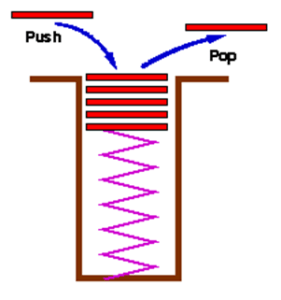Stack Data Structure complete code using Array and link list
and its application,
A stack is an ordered collection of items into which new items may be inserted and from which items may be deleted at one end called the TOP of the stack
What are the properties of these stacks?
You can only add an item (book shirt etc) on top of the stack and you can only remove it from the top too
BASIC OPERATIONS WITH STACKS
Push
🞤 Add and item
🞫 need to check overflow
Pop
🞤 Remove an item
🞫 need to check underflow
stackTop
🞤 What’s on the Top
🞫 Could be empty
Push
- Adds a new data element to the top of the stack

Stack Push Method
Pop
- Removes a data element from the top of the stack

StackTop
- Checks the top Stack is not changed

- Stacks in real life: stack of books, stack of plates
- Add new items at the top
- Remove an item at the top
- Stack data structure similar to real life: collection of elements arranged in a linear order.
- Can only access element at the top
- A stack is an ordered collection of items into which new items may be inserted and from which items may be deleted at one end only, called top of the stack. i.e. deletion/insertion can only be done from top of the stack
- The insert operation on a stack is often called Push operation and delete operation is called Pop operation.
OPERATION ON STACK
A Stack should have the following methods
- push(item) //Push an item onto the stack
- pop( ) //Pop an item off the stack
- isEmpty() //Return true if stack is empty.
- Isfull( ) //Return true if stack is full
Basic operation code
Stack by using an Array
#include “stdafx.h”
#include<iostream>
#include<conio.h>
#include<stdlib.h>
using namespace std;
class stack
{
int stk[5];
int top;
public:
stack()
{
top = -1;
}
void push(int x)
{
if (top > 4)
{
cout << “stack over flow”;
return;
}
stk[++top] = x;
cout << “inserted” << x << endl;
}
void pop()
{
if (top <0)
{
cout << “stack under flow”;
return;
}
cout << “deleted” << stk[top–];
}
void display()
{
if (top<0)
{
cout << ” stack empty”;
return;
}
for (int i = top; i >= 0; i–)
cout << stk[i] << ” “;
}
};
int main()
{
int ch;
stack st;
while (1)
{
cout << “\n1.push \n2.pop \n3.display \n4.exit\n\nEnter ur choice”;
cin >> ch;
switch (ch)
{
case 1: cout << “enter the element”;
cin >> ch;
st.push(ch);
break;
case 2: st.pop(); break;
case 3: st.display(); break;
case 4: exit(0);
}
}
return (0);
}
Stack by using linklist
#include “stdafx.h”
#include <iostream>
#include <stdio.h>
#include <conio.h>
using namespace std;
struct node
{
int data;
node *next;
}*p = NULL, *r = NULL, *q = NULL, *t = NULL;
void push(int x)
{
t = new node;
t->data = x;
t->next = NULL;
if (p == NULL)
{
p = t;
}
else
{
t->next = p;
p = t;
}
}
int pop()
{
int x;
if (p == NULL)
{
cout << “emqty queue\n”;
}
else
{
q = p;
x = q->data;
p = p->next;
delete(q);
return(x);
}
}
int main()
{
/*int n, c = 0, x;
cout << “Enter the number of values to be qushed into stack\n”;
cin >> n;
while (c < n)
{
cout << “Enter the value to be entered into queue = “;
cin >> x;
push(x);
c++;
}
cout << “\n\nRemoved Values\n\n”;
while (true)
{
if (p != NULL)
cout << remove() << endl;
else
break;
}
//write system pause command here
int ch;
while (1)
{
cout << “\n1.push \n2.pop \n3.exit\n\nEnter ur choice”;
cin >> ch;
switch (ch)
{
case 1: cout << “enter the element”;
cin >> ch;
push(ch);
break;
case 2: pop(); break;
case 3: exit(0);
}
}
return (0);
}
- How to access the top of the stack
- How to push data onto the stack
- How to pop data from the stack
Related links
Single link list Stack AVL Trees Binary search Counting Sort
Doubly link list Queue Graphs Bubble Sort Radix sort
Circular link list Binary search tree Hashing Insertion Sort Bucket Sort
Josephus Problem Tree Traversal Heaps Quick Sort Merge Sort
At Cui tutorial, courses, past papers and final year projects
#tutorial #cui #pastpaper #courses

